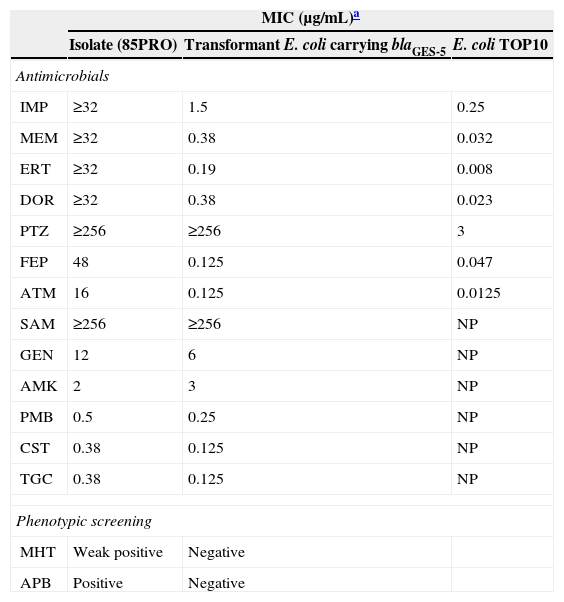GES-type enzymes belong to Ambler Class A plasmid-encoded β-lactamases. Although GES enzymes usually exhibit extended-spectrum β-lactamases (ESBL) properties, changes in its active site enhance its activity conferring the ability to hydrolyze carbapenems.1 GES-type carbapenemases (GES-2, GES-4, GES-5, GES-8, GES-11, GES-18, GES-20) have already been described in several countries.2 Although it has been reported in a Klebsiella pneumoniae from Brazil in 2010, in a patient admitted in 2008,3 no other isolate has ever since been reported in this country. Here, we described another carbapenem-resistant K. pneumoniae (CRKP) isolate carrying the blaGES-5 gene in Brazil.
The CRKP, identified by VITEK2 system (bioMeriéux, France), was recovered from the blood of an adult patient admitted to a university hospital in Porto Alegre, Brazil, in 2011. The patient had acute myeloid leukemia with recent exposure to many antibiotics including piperacillin–tazobactam, polymyxin B, meropenem, vancomycin, and cefepime. Despite treatment with polymyxin B and tigecycline, the patient ultimately died six days after CRKP recovering.
Minimum inhibitory concentrations (MICs), performed by Etest®, and the phenotypic tests for carbapenemases detection are shown in Table 1. The presence of blaGES was demonstrated by multiplex real-time PCR that also included blaKPC, blaVIM, blaNDM, blaOXA-48 and blaIMP genes.4 Sequencing of blaGES gene was performed using the primers previously described.5 GenBank was used to access the GES sequences deposited to date and BioEdit program was used to compare the similarity between sequences, and revealed the presence of a GES-5. Plasmidial DNA from CRKP was obtained from alkaline lysis and it was electroporated into an Escherichia coli Top10 (Invitrogen). Transformants were selected on Luria-Bertani agar containing 0.5μg/mL of ceftazidime. The plasmid electroporation resulted in transformants, which confirmed the presence of blaGES by PCR (Table 1).
Phenotypic characterization of Klebsiella pneumoniae and Escherichia coli transformant carrying blaGES-5.
| MIC (μg/mL)a | |||
|---|---|---|---|
| Isolate (85PRO) | Transformant E. coli carrying blaGES-5 | E. coli TOP10 | |
| Antimicrobials | |||
| IMP | ≥32 | 1.5 | 0.25 |
| MEM | ≥32 | 0.38 | 0.032 |
| ERT | ≥32 | 0.19 | 0.008 |
| DOR | ≥32 | 0.38 | 0.023 |
| PTZ | ≥256 | ≥256 | 3 |
| FEP | 48 | 0.125 | 0.047 |
| ATM | 16 | 0.125 | 0.0125 |
| SAM | ≥256 | ≥256 | NP |
| GEN | 12 | 6 | NP |
| AMK | 2 | 3 | NP |
| PMB | 0.5 | 0.25 | NP |
| CST | 0.38 | 0.125 | NP |
| TGC | 0.38 | 0.125 | NP |
| Phenotypic screening | |||
| MHT | Weak positive | Negative | |
| APB | Positive | Negative | |
IPM, imipenem; MEM, meropenem; ERT, ertapenem; DOR, doripenem; SAM, ampicillin-sulbactam; TZP, piperacillin-tazobactam; FEP, cefepime; ATM, aztreonam; GEN, gentamicin; AMK, amikacin; PMB, polymyxin B; CST, colistin; TGC, tigecyclin; MHT, Modified Hodge Test; APB, combined-disk with phenyl boronic acid; NP. Not perfprmed.
We reported the second case of a CRKP carrying the blaGES-5 gene in Brazil. Although the first GES-5-producing CRKP was reported in São Paulo in 2008,3 there has been no other report of this enzyme in Enterobacteriaceae since then in Brazil. Unlike the other class A carbapenemase, KPC, widespread dissemination of GES-carbapenemase-producing isolates in this country has not occurred. Nevertheless, it must be noted that screening for carbapenemases other than KPC has not been routinely performed in most laboratories in Brazil. Although the prevalence is likely low, especially if compared to KPC-2, the real prevalence of GES-5-producing isolates could be underestimated.
Similar to the GES-5 CRKP isolate from São Paulo, the MICs of carbapenems in the transformant dramatically declined to susceptibility levels for meropenem and doripenem, but to 1.5μg/mL to imipenem, indicating that other mechanisms, such as those demonstrated in the São Paulo isolate (loss or modifications in porin),3 are critical to the high level resistance to carbapenems. Unfortunately, we have not investigated porins in our isolate. Additionally, we have neither investigated the genetic environment of blaGES-5 nor the presence of other resistance genes. Of note, the transformant showed low-level resistance to gentamycin, possibly indicating the presence of an aminoglycoside modifying enzyme.
Also of note, modified Hodge test resulted in a weak positive, making its interpretation difficult; in contrast, the combined-disks assay with boronic acid was positive as expected for a Class A carbapenemase-producing isolates. Surprisingly, however, boronic acid test was negative in the transformant. These findings warrant further investigation.
In summary, we report a second CRKP carrying the blaGES-5 gene, recovered in another Brazilian region. Although the prevalence of this enzyme is likely to be rare among Enterobacteriaceae isolates from Brazil, properly powered surveillance studies fully representative of all Brazilian regions are necessary to determine its real prevalence in our country.
Conflicts of interestThe authors declare no conflicts of interest.
This work was supported by Fundo de Incentivo à Pesquisa e Eventos do Hospital de Clínicas de Porto Alegre, Coordenação de Aperfeiçoamento de Pessoal de Nível Superior and Fundação de Amparo à Pesquisa do Estado do Rio Grande do Sul, Brazil.





